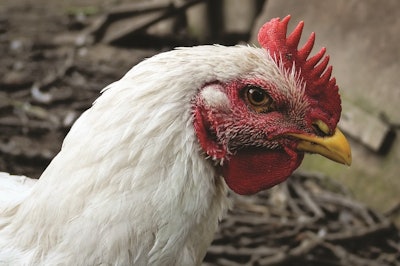
Global meat production is projected to reach 377 million metric tons (mmt) over the next few years as meat prices recover after the pandemic and feed costs decrease, according to the Organization for Economic Co-operation Development (OECD) and the Food and Agriculture Organization (FAO).
The production share of OECD and FAO’s world’s top five meat producers ‒ China, the U.S., the EU, Brazil and the Russian Federation ‒ will slowly trend down from its current level due to a decline in production from the EU and an expanding base of global production. According to the U.S. Department of Agriculture (USDA), India will replace the Russian Federation’s spot in the top five by 2031.
Like previous years, Asia will make up almost 40% of 2022’s global poultry production with 54.9 mmt by the end of the year, according to FAO (Figure 1). North America will remain a large contributor at 24.9 mmt, followed by South America and Europe.
Poultry leads
Poultry will continue to be the primary driver of global meat production growth, increasing by 2.5% from the average in 2019-21 to almost 136 mmt by the end of 2022 and 153.9 mmt in 2031 (Figure 2). This will be mostly due to poultry’s lower feed conversion rates compared to other animals and its short production cycle, along with its price point compared to other protein sources. These circumstances allow producers to quickly react to market shifts and improvements in genetics, animal health and feeding practices.
Demand for poultry meat is strong post-COVID and will continue to be solid into 2023, according to Rabobank. However, increasing feed and energy prices are not expected to fall soon. Along with the pressures of the most recent highly pathogenic avian influenza (HPAI) outbreak, operations will be what challenges producers the most in the near future.
While poultry leads meat production growth, pig meat production remains the second-greatest contributor to global meat production and is predicted to reach 125.6 mmt by the end of 2022, up from 122.5 mmt in 2021 (Table 1). According to the OECD and FAO, the swine industry will continue to be challenged by its slow recovery from the African Swine Flu (ASF) outbreaks in China, the Philippines and Vietnam. In addition, the swine industry has a less favorable carbon footprint compared to the poultry industry.
Update: Asia, Europe, EU, US and Brazil
Poultry’s market share of the Asia and Pacific regions will see expansion as the shift away from pig meat triggered by several ASF outbreaks will continue to benefit poultry, even though recovery from the outbreak to normal meat production levels is expected. The USDA says that China’s poultry meat production is expected to reach 14.3 mmt by the end of 2022 (Figure 3).
The EU is expected to have a decline in overall meat production due to rising domestic and environmental costs, as well as reduced export opportunities due to more competition in global markets. While pork will remain the most consumed meat in the E.U. over the coming decade, changes in diets are expected to favor poultry.
Even though Europe’s HPAI outbreak during the 2021-2022 season has been described as the worst ever in the country, the FAO predicts that Europe’s poultry meat production will reach almost 22 mmt by the end of 2022 (Figure 1).
The U.S. saw record-high prices with strong retail and foodservice demand in 2022. The USDA predicts that U.S. poultry meat production will reach 51.2 billion pounds (23.2 mmt) by the end of 2022, with 45.3 billion pounds (20.5 mmt) of that being broiler meat and 5.4 billion pounds (2.4 mmt) of turkey meat (Table 2). Poultry meat is expected to hit 51.8 million pounds (23.5 mmt) in 2023.
According to the USDA, Brazil is the third-largest chicken meat producer in the world behind the U.S. and China. Chicken production will continue to grow in 2022, increasing by 2% to 14.7 mmt (Figure 4). The growth is attributed to the country’s increase in exports, as some of its larger competitors, such as China, are unable to satisfy their export markets due to disease or war.
Poultry meat efficiency is key
Poultry meat production is anticipated to grow over the next 10 years in response to demand from growing populations and rising incomes in developing economies. However, the increase is not fully attributed rising incomes. At the same time, production costs have decreased, along with improved meat yields and feed conversion ratios (FCR), making poultry meat even more accessible.
According to the OECD and FAO, China had the best poultry FCR in average 2019-21 of 1.37, followed by the U.S., Brazil and Canada, all documenting a FCR of 1.73.
From a sustainability perspective, a lower inventory of animals or capital is needed to produce poultry meat, while a declining feed conversion ratio suggests a lesser need for additional feed. Even though greenhouse gas emissions are projected to grow by 9% by 2031 due to increases in cattle, pig, poultry and sheep inventories, this will be less than the rise in meat production.
Additionally, these productivity improvements are one of the reasons the poultry industry is more secure than other industries during times of lower grain supplies, such as the war in Ukraine, and this should serve the industry well over the decade ahead.
United States turkey meat production 2010-20
Mexico turkey meat production 2010-20
Russian Federation chicken meat production 2010-20
Poland turkey meat production 2010-20
Indonesia chicken meat production 2010-20
Iran chicken meat production 2010-20















